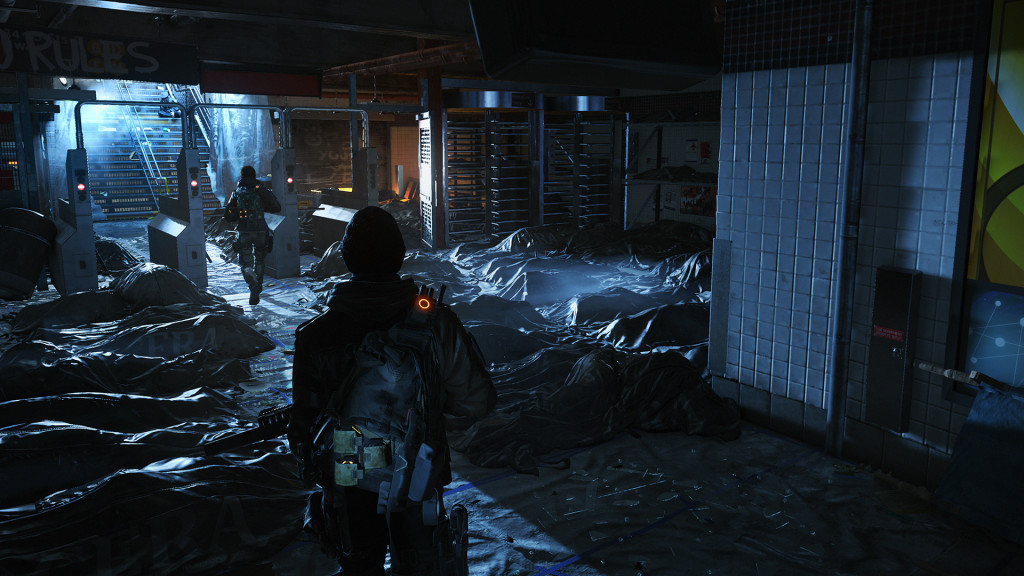There’s something uniquely horrid about the prospect of biological warfare. There’s the obvious: diseases like ebola are strong candidates for the very worst way a person can die. Then there’s the careless, wanton nature of the destruction: unlike other weapons, you can’t ‘aim’ a plague.
This post originally appeared on Kotaku UK, on 3 June 2015.
It feels profoundly unfair to be killed by something not targeted at you, and something you can’t see, hear, smell or feel to boot. Whatever your feelings about being shot, burnt, choked or blown up (and mine are quite negative), they are at least tangible. Bioterrorism’s just… Well, it’s not cricket, is it?
I’ve found bioterrorism — the use of disease as a weapon against regular people — weirdly fascinating since I read Richard Preston’s novel, The Cobra Event, aged 11 or 12 (categorically the wrong age to read that book, incidentally). Now it’s become the subject of my postgraduate degree and I’ve spent weeks rifling through books and dozens of academic papers about it. My focus is on one case study in particular: a US government exercise called Dark Winter, which simulated the effects of a terrorist release of smallpox in the United States.
Evidently, someone at Ubisoft was doing the same thing a few years before me. The Division, Ubisoft’s third-person shooter MMO, puts the player into the role of a sleeper agent whose job it is to maintain order in (and eventually rebuild) New York in the aftermath of a disastrous, deliberate outbreak of smallpox, transmitted via bank notes. Ubisoft released the three-and-a-half-minute CGI trailer below at E3 2013, explaining Dark Winter and the influence it had on the game. I thought it’d be fun to dig a little deeper and see just how plausible its biological doomsday attack really might be. If fun is the right word. Which it isn’t.
First things first: what was Dark Winter? As the trailer says, it was a 2001 (pre-9/11) exercise that simulated a bioterrorist attack on the US. The roles of the President, the cabinet and a few other key politicians were played by senior government officials and advisors. This is its official webpage, which explains it all in detail. You can also download the full 44-page script of the exercise here. I really recommend you do, it’s gripping reading.
The basic set-up is this: in the run-up to Christmas, an unknown terrorist group releases smallpox in three shopping centres in Georgia, Pennsylvania and Oklahoma. At the same time, Iraqi forces are building up along the border with Kuwait. The US responds with a large troop deployment (this becomes important later). As the disease spreads, the President and his advisors are given periodic updates from different branches of the government, the military and the media. The scenario then played out interactively a bit like a TellTale game: what sort of quarantines do you impose, do you recall troops from the Gulf and so on?
As the Division trailer says, the simulation spirals out of control (although in fairness, it was never designed to be ‘solvable’ — the point was to highlight weaknesses in the US response to a bioterrorist attack, not make a video game).
What did we learn from the simulation? Broadly what the trailer describes: that a serious attack with a biological weapon could lead to a rapid “breakdown in essential institutions”, “civil disorder” and “massive civilian casualties” (two things to remember, though: first, this simulation is now nearly 15 years old; and second, there have been some criticisms of the disease model it used for smallpox. Don’t move out to the woods yet).
In the simulation and the trailer, this is where things get juicy, so let’s tackle each of these claims in turn.
Breakdown in essential institutions

One of the many potential problems with bioterrorism is fear. Chemical weapons, radiological weapons (in which the dispersal of radiological material causes the harm, not the explosion itself) and nuclear weapons are immediately obvious in their effects: there’s a bang, or people start choking and falling over. Biological weapons don’t work that way. A disease weapon will have an incubation period — the time from when a person is infected to when they start showing symptoms — just like diseases in the wild. If you’re a victim of bioterrorism, you likely won’t know you’re infected until you start showing symptoms.
In the context of a bioterrorist attack, this leads to a phenomenon known as the ‘worried well’. People who aren’t sick hear about the disease, panic and flood hospitals thinking that they are. That creates a logjam of patients, many of whom don’t need treatment at all. Worse, it means that healthy people are now stuffed in waiting rooms full of people who (potentially) really are sick.
For essential institutions to stop working, it almost doesn’t matter what the illness actually is. Services stop working when the people who run them stop going to work. And a really nasty disease (in the interests of keeping this SFW, click here for an image gallery of what smallpox does to a person) doesn’t just frighten the general public — it scares the shit out of doctors, nurses and first-responders, too. Absenteeism, especially among medical workers, is a serious concern in prepping a bioterrorism response. If doctors and ambulances stop turning up to help the sick, things go from bad to worse very quickly.
Civil disorder

Because there is so little public information about diseases like smallpox, getting people to do what’s best for them in the event of an outbreak is tricky. The ebola outbreak in Africa provided a wealth of tragic examples of counterproductive behaviour, all of which stem from a lack of education and understanding: people catching ebola through burial rituals, sick and healthy praying together in churches, conspiracy theorists spreading hokum and so on. The worst eventuality, however, is panic.
Dark Winter showed how easily an infectious disease could spread across the US (and the world) if its incubation period is long enough to allow an unwitting infected person to get onto a plane. From a government’s perspective, once you know you have something like smallpox in a city like New York, you want to do everything possible to keep it there. The problem is, once people in New York know there’s something like smallpox there, they really, really want to leave.
And how do you stop them? Because smallpox was eradicated from nature in 1979 (only two stocks of variola virus, which causes smallpox, officially exist: one at the Center for Disease Control and Prevention in the US, the other at the Russian State Research Center of Virology and Biotechnology in Siberia), law enforcement aren’t vaccinated against it. There are good reasons for this: first among them that smallpox vaccine is (compared to most other vaccinations) pretty dangerous. Complications are extremely rare, but can cause all sorts of side-effects in a very, very unlucky few, including death. If the risk of death is higher than the risk of a smallpox attack, the right cost-benefit choice is not to vaccinate.
Of course, if you get that wrong, as the US government seems to have in The Division, that creates a problem. Worst case, you get a panicked population — some of whom are trying to escape the city, some of whom are looting shops and hospitals — and a police force that doesn’t much fancy the prospect of wading out unprotected into an angry mob of sick people. Like doctors, police officers have their own welfare to think about, as well as the welfare of their families.
Incidentally, the US has vaccinated some of its military and medical personnel, in preparation for both bioterrorist attack and the possibility that smallpox (which has a centuries-old history of use as a bioweapon) might be used against its troops overseas. When The Division’s Dark Winter story trailer talks vaguely about “sleeper cells”, this could be the sort of initiative it’s referencing.
Massive civilian casualties

Ah, the big one. It wouldn’t be much of a game if everyone dramatically took some Benadryl and got better.
Hollywood can paint an overly doom and gloom picture of a deadly disease. In the 1995 film Outbreak, for example (SPOILERS), everyone who comes into contact with a disease — which the US military has been secretly stockpiling for use as a bioweapon — dies. Everyone. Even Kevin Spacey.
That might be the ideal if you’re committing a biological attack, but in reality, the happy truth is that lots of people survive outbreaks of diseases commonly considered good bioweapon candidates without any help at all. Smallpox, for example, kills about 30 per cent of those infected (without vaccination). There are definitely worse diseases out there if lethality is all you care about. The most dangerous known strain of ebola kills 90 per cent of those infected, for example. But the trade-off is that it isn’t anywhere near as infectious. You need to be really close to an ebola patient (or their bodily fluids) to catch the disease yourself. From a terrorist standpoint, each candidate for a bioweapon has pros and cons.
A big ‘con’ for both smallpox and flu is the existence of vaccines. Smallpox is particularly vulnerable in this regard, because you can even administer its vaccine after exposure. So long as you vaccinate the patient no later than three-to-four days after infection (which is before they become symptomatic), there’s an excellent chance they will be fine. Which is great if you’re a patient, but really annoying if you’re a bioterrorist. And while in 2001 the US had a limited supply of vaccine (15 million doses), in the years since that stockpile has been increased to cover everyone in the country. That isn’t to say an attack wouldn’t be devastating, just not the literal end of the world.
The worst case bioterrorism scenario, however, would be dealing with a disease which had been designed to defeat a healthcare system.
The Soviet Union’s bioweapons programme was built to produce weapons just like this. A lot of what we know about it comes from one man: a defector named Ken Alibek who effectively ran the programme for about four years. In his book, which is also an interesting read, he outlines a key philosophical difference between the Soviet and US bioweapons programme: while the US wanted weapons that could be treated in case of an accidental release around its own troops and lab workers, the Soviet Union wanted exclusively weapons for which no treatment existed.
Are we all going to die?

Yes!
But probably not because of bioterrorism.
Fortunately, the chances of a properly devastating outbreak like the one in The Division are low, at least as the result of a bioterrorist plot. One criticism you can make of Dark Winter is that it starts after the terrorists have done all the hard bits, like making the weapon, dispersing it and so on. There are lots of hoops to jump through before you reach day one of the Dark Winter exercise, because, happily, there are lots of practical problems with using disease as a weapon.
For one thing, it’s pretty difficult to handle a deadly biological weapon without killing yourself. For reference, this is the kind of suit that CDC doctors use when handling smallpox. The suits are airtight and that yellow hose keeps pressure inside the suit positive, so if you tear it or stick yourself with a sharp thing, air rushes out of the suit, keeping anything nasty away from your body. You can’t make or keep this kind of stuff in your bathtub.
Secondly, there’s a problem of dispersal. Most diseases don’t do well outside of their natural hosts. Most viruses and bacteria break down under UV light, which means from the moment an aerosolised weapon (one that floats in a handy breathable cloud) hits daylight, it’s becoming less and less dangerous each second.
There are other environmental hurdles, too. If it’s too windy, your weapon gets blown away or up into the sky. If it’s not windy enough, it doesn’t spread properly. And if it rains, all your hard work literally goes down the drain.
This isn’t speculation: Japan’s Aum Shinrikyo cult found all this out the hard way.
The cult is famous for its 1995 attack on the Tokyo subway, in which it used a chemical weapon to kill 12 people and injure about 1000 others. What you might not know about Aum Shinrikyo is that it plumped for Sarin after a long (and grimly bumbling) history of trying to acquire a functioning bioweapon. It’s a long story (if you’re a student, you might be able to read it here), but basically involves the cult putting anthrax and botulinum toxin into a van and then driving round and round Tokyo, not infecting anyone. Why is this relevant? Because Aum Shinrikyo had time, (some) expertise, a boatload of cash and a single-minded drive to acquire and use a bioweapon. And screwed it up over and over again before eventually trying something easier.
Finally, getting hold of an actual bioweapon — something designed to beat a healthcare system by resisting treatment, spreading abnormally quickly and so on — is a lot harder today than it used to be (maybe to the point of impossibility). There are no countries in the world which admit to pursuing biological weapons today, and almost all are signatories to the Biological Weapons Convention. That doesn’t mean the expertise isn’t out there — people who worked in these Cold War programmes are still alive today — only that R&D and production on any kind of serious scale have stopped, and the global consensus has shifted from ‘it’s OK to have stockpiles of bioweapons’ to ‘it is absolutely not OK to have stockpiles of bioweapons’.
I don’t know how to feel about all this

Don’t worry. It’s broadly positive. Again, the most critical thing that The Division shares with Dark Winter is that it glosses over the challenges of procuring a biological weapon in the first place and skips straight to the outbreak. That’s a bit like worrying what a chimpanzee would do with an Abrams Tank. Unless someone leaves one lying around the monkey enclosure with the hatch open, it’s probably pre-emptive to fret about it (unless you’re part of a government commission whose to job is to fret about it, in which case, load up the poisoned banana cannon).
And that’s fine: Dark Winter was supposed to show the weaknesses in the US healthcare system in the event of a massive disease outbreak, and The Division is a piece of entertainment. They’re meant to be provocative, worst-case scenarios, not prophecies. Which is a good thing, when you consider that a realistic, video game adaptation of the best-funded, most expertly constructed bioterrorist operation to date — the Aum Shinrikyo attacks — would look less like The Division and more like Euro Truck Simulator.
You OK? It’s going to be fine. Here is a calming image of a baby rabbit.



Comments
5 responses to “The Truth Behind The Division’s Bioterrorist Apocalypse”
So like… how slow does a news day have to be for us to get 10 month-old reposts from the overseas sites?
I’d argue that it’s far more interesting and relevant now compared to when it was originally published because people have now had a chance to play The Division.
And there’s that Division update that just went out 24 hours ago too!
Actually that was an incredibly interesting and well researched read. Thanks for bringing it back. I missed it the first time around.
Now please explain the Walking Dead virus because I still don’t understand that one!
Well…you see….. magic.